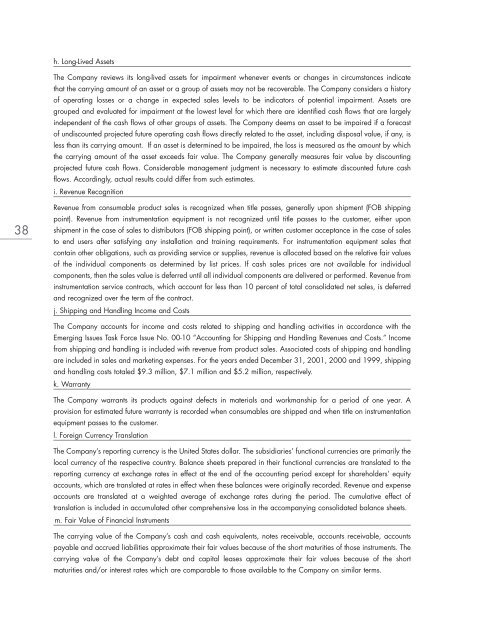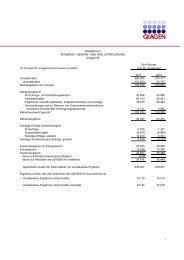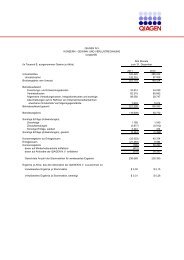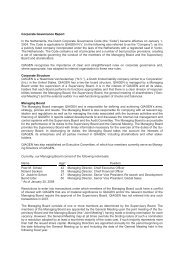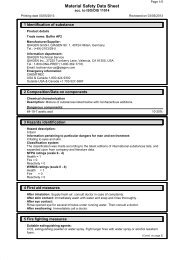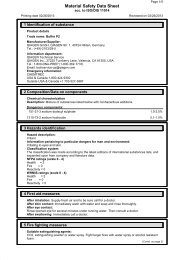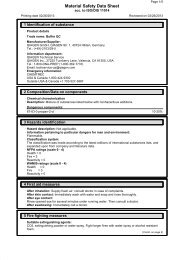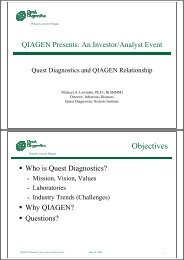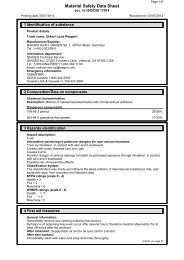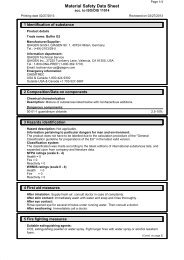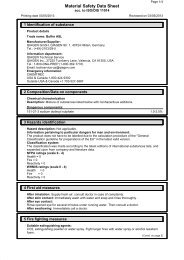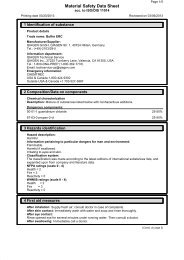QIAGEN N.V. Annual Report 2001
QIAGEN N.V. Annual Report 2001
QIAGEN N.V. Annual Report 2001
Create successful ePaper yourself
Turn your PDF publications into a flip-book with our unique Google optimized e-Paper software.
h. Long-Lived Assets<br />
The Company reviews its long-lived assets for impairment whenever events or changes in circumstances indicate<br />
that the carrying amount of an asset or a group of assets may not be recoverable. The Company considers a history<br />
of operating losses or a change in expected sales levels to be indicators of potential impairment. Assets are<br />
grouped and evaluated for impairment at the lowest level for which there are identified cash flows that are largely<br />
independent of the cash flows of other groups of assets. The Company deems an asset to be impaired if a forecast<br />
of undiscounted projected future operating cash flows directly related to the asset, including disposal value, if any, is<br />
less than its carrying amount. If an asset is determined to be impaired, the loss is measured as the amount by which<br />
the carrying amount of the asset exceeds fair value. The Company generally measures fair value by discounting<br />
projected future cash flows. Considerable management judgment is necessary to estimate discounted future cash<br />
flows. Accordingly, actual results could differ from such estimates.<br />
i. Revenue Recognition<br />
38<br />
Revenue from consumable product sales is recognized when title passes, generally upon shipment (FOB shipping<br />
point). Revenue from instrumentation equipment is not recognized until title passes to the customer, either upon<br />
shipment in the case of sales to distributors (FOB shipping point), or written customer acceptance in the case of sales<br />
to end users after satisfying any installation and training requirements. For instrumentation equipment sales that<br />
contain other obligations, such as providing service or supplies, revenue is allocated based on the relative fair values<br />
of the individual components as determined by list prices. If cash sales prices are not available for individual<br />
components, then the sales value is deferred until all individual components are delivered or performed. Revenue from<br />
instrumentation service contracts, which account for less than 10 percent of total consolidated net sales, is deferred<br />
and recognized over the term of the contract.<br />
j. Shipping and Handling Income and Costs<br />
The Company accounts for income and costs related to shipping and handling activities in accordance with the<br />
Emerging Issues Task Force Issue No. 00-10 ”Accounting for Shipping and Handling Revenues and Costs.” Income<br />
from shipping and handling is included with revenue from product sales. Associated costs of shipping and handling<br />
are included in sales and marketing expenses. For the years ended December 31, <strong>2001</strong>, 2000 and 1999, shipping<br />
and handling costs totaled $9.3 million, $7.1 million and $5.2 million, respectively.<br />
k. Warranty<br />
The Company warrants its products against defects in materials and workmanship for a period of one year. A<br />
provision for estimated future warranty is recorded when consumables are shipped and when title on instrumentation<br />
equipment passes to the customer.<br />
l. Foreign Currency Translation<br />
The Company’s reporting currency is the United States dollar. The subsidiaries’ functional currencies are primarily the<br />
local currency of the respective country. Balance sheets prepared in their functional currencies are translated to the<br />
reporting currency at exchange rates in effect at the end of the accounting period except for shareholders’ equity<br />
accounts, which are translated at rates in effect when these balances were originally recorded. Revenue and expense<br />
accounts are translated at a weighted average of exchange rates during the period. The cumulative effect of<br />
translation is included in accumulated other comprehensive loss in the accompanying consolidated balance sheets.<br />
m. Fair Value of Financial Instruments<br />
The carrying value of the Company’s cash and cash equivalents, notes receivable, accounts receivable, accounts<br />
payable and accrued liabilities approximate their fair values because of the short maturities of those instruments. The<br />
carrying value of the Company’s debt and capital leases approximate their fair values because of the short<br />
maturities and/or interest rates which are comparable to those available to the Company on similar terms.


